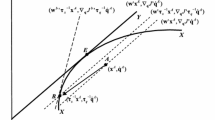Abstract—
The article examines the dynamics and structure of the resource intensity of agricultural production in Russia using the methodology of input–output tables. Russian and international databases for analyzing the resource intensity of industry complexes are generalized and their advantages and disadvantages are revealed. The article presents a grouping of cost items in agricultural production to assess the level and structure of resource intensity for certain types of resources. The main trends in the dynamics and structure of resource intensity in agricultural production are revealed.




Similar content being viewed by others
Notes
Hereinafter, all notation and abbreviations in formulas are in accordance with the terms generally accepted in international statistics: C—Costs, II—Intermediate Inputs, GO—Gross Output. Cost indicators can be expressed in any currency.
The group of costs for other products includes numerous costs for auxiliary resources in the production of agricultural products, the volume and share of which individually do not have a significant effect on output.
The recalculation of resource costs from current to constant prices was carried out on the basis of the price indices of the products of the corresponding industries. The general price index for the group of costs considered in this paper is the weighted average of all price indices for the industries included in the group. The share of products of each industry in the structure of products by group was used as a weighting factor.
REFERENCES
V. V. Ivanter, “Role of input-output model in macroeconomic analysis and forecasting,” Stud. Russ. Econ. Dev. 29, 581–583 (2018).
Clopper Almon, “Why are input-output tables important?,” Stud. Russ. Econ. Dev. 29, 584–587 (2018).
A. A. Shirov, “Use of input–output approach for supporting decisions in the field of economic policy,” Stud. Russ. Econ. Dev. 29, 588–597 (2018).
S. A. Andryushchenko and M. Ya. Vasil’chenko, “Methodology of input-output balance in strategic management of the production potential of the agro-industrial complex of Russia,” Agrar. Nauchn. Zh., No. 8, 68–74 (2015).
National Input-Output Tables, Released November 2016. http://www.wiod.org/new_site/database/niots.htm.
M. Yu. Ksenofontov and D. A. Polzikov, “Retrospective structural shifts in the Russian economy,” Stud. Russ. Econ. Dev. 29, 625–636 (2018).
A. P. Potapov, “Assessment of the dynamics of resource costs and resource intensity of agricultural production in Russia,” Agrar. Nauchn. Zh., No. 5, 85–91 (2018).
Indicators of National Accounts of Russia in 2011–2019. Statistical Yearbook (Rosstat, Moscow) [in Russian]. https://rosstat.gov.ru/central-news/document/94312.
Federal State Statistics Service. Prices. https://rosstat.gov.ru/price.
Unified Interdepartmental Information and Statistical System (EMISS). https://fedstat.ru.
Russian Statistical Yearbook. 2019 (Rosstat, Moscow, 2019) [in Russian].
Agriculture in Russia. 2019: Statistical Yearbook (Rosstat, Moscow, 2019) [in Russian].
Volume of Production of Greenhouse Vegetables Is Sufficient to Supply the Russian Market. Ministry of Agriculture of the Russian Federation. http://mcx.ru/press-service/news/obemov-proizvodstva-ovoshchey-zakrytogo-grunta-dostatochno-dlya-obespecheniya-rossiyskogo-rynka.
National Report “On the Progress and Results of the Implementation of the State Program for the Development of Agriculture and Regulation of Markets for Agricultural Products, Raw Materials, and Food in 2019” (Minist. Sel’sk. Khoz. Ross. Fed., Moscow, 2020) [in Russian].
Federal State Statistics Service. Investments in Non-Financial Assets. https://rosstat.gov.ru/investment_nonfinancial.
A. P. Potapov, “Assessment of the volume of agricultural production depending on the structure of resource costs,” Ekon. Nauki, No. 6, 74–79 (2020).
Author information
Authors and Affiliations
Corresponding author
Ethics declarations
The authors declare that they have no conflicts of interest.
Rights and permissions
About this article
Cite this article
Potapov, A.P. The Use of Input–Output Tables in the Study of the Dynamics and Structure of the Resource Intensity of Agricultural Production. Stud. Russ. Econ. Dev. 32, 177–183 (2021). https://doi.org/10.1134/S1075700721020088
Received:
Revised:
Accepted:
Published:
Issue Date:
DOI: https://doi.org/10.1134/S1075700721020088




